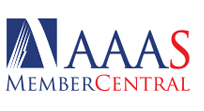
Consider the placenta.
“It’s a confusing thing for most people to understand what on earth this weird blob of tissue is that comes out after the baby,” says researcher Jessica Hebert. “Think of this: It’s the only temporary organ that humans make and it’s responsible for transporting blood and nutrients and waste to and from the baby.”
 Midway through a Ph.D. program in biology at Portland State University, new AAAS member Hebert is snagging attention for her research on this misunderstood organ. She won Best Overall Poster at the AAAS Pacific Division Meeting, and first place in the Sigma Xi Biological Honor Society Poster Competition, Biomedical.
Midway through a Ph.D. program in biology at Portland State University, new AAAS member Hebert is snagging attention for her research on this misunderstood organ. She won Best Overall Poster at the AAAS Pacific Division Meeting, and first place in the Sigma Xi Biological Honor Society Poster Competition, Biomedical.
Standing by her poster with a 3-D printed model of an enlarged mouse placenta in her hand, Hebert describes the wondrous workings of the placenta to anyone who will listen.
“By understanding the placenta … we can understand a lot about what is going on with baby’s growth and development,” she says. “Not just in utero, but what’s it’s going to be like in the future.”
To better understand its structure, Hebert is working in the lab of Oregon Health and Science University pathologist Terry Morgan to examine aspects of placental insufficiency, such as preeclampsia—a condition which affects about 5 to 8 percent of all pregnant women.
Sometimes called toxemia, preeclampsia is marked by high blood pressure, elevated protein in the urine, and swelling in the mother’s feet and hands. Many babies born of preeclamptic mothers are smaller in size; they are more likely to have hypertension and obesity in later life. In turn, they may be more likely to be preeclamptic in pregnancy.
In an effort to pinpoint possible structural causes of preeclampsia, Herbert has been studying the mother’s blood vessels, called uterine spiral arteries, which attach to the uterus at the placenta. There, the blood slows down so it can be exchanged through the baby’s tiny capillaries.
“You would expect mom to have all the influence in how these blood vessels develop,” says Hebert, “but we found that if babies had a particular genetic marker that is prevalent in hypertension and preeclampsia—and if those babies were boys—then the spiral arteries were very bad.”
Conversely, if the baby was a girl, the mother’s uterine spiral arteries were more likely to look fine—even if the baby had the genetic marker for preeclampsia.
“The field blames the mom for preeclampsia largely,” notes Hebert. “But if we can better understand the particular factors that baby is influencing in placental growth then maybe we can make better preventative and intervening treatments for moms who have preeclampsia.”
Hebert—who says that she wants to study babies because they will “grow up to be my future interns”—alternates between focused scientific discussion and hearty humor.
“When I first moved to Portland,” she recounts, “I was trying to get a job and had a hard time getting interviews for science.” Pause. “And so I became a pirate.”
“It’s not extremely lucrative,” she continues, “but the money doesn’t hurt.” Another pause. “My husband is a fire eater.”
Aye, Hebert is part of a group of professional pirates who call themselves PDXYAR, aka “The Swashbucklers of Stumptown.” Performing at events and festivals, they have do fire dancing and stage combat, have fully active cannons, and sing sea chanties from the 17th and 18th century.
“I still am a pirate in grad school but my priority is my work,” she clarifies.
Hebert’s flamboyance, coupled with a fierce love of science, makes her a popular teacher—a calling she holds dear. Currently, she is a graduate teaching assistant for several PSU biology classes. She also does public outreach and podcasting.
“I’m so passionate about teaching, nothing is going to keep me out of the classroom,” she says—although she acknowledges that the trend toward adjunct professorships presents real obstacles for those seeking academic careers.
“One way or another, even if I’m not in a lecture hall, there will still be an avenue for me to teach or be a mentor. As long as my voice and my hands are still working, I will teach,” she says, adding, “I’ve been described as tenacious.”
Hebert is the first in her family to go to college and the only scientist many of her friends and family know. “I get to be their connection to the science world. They ask me really great questions that make me research harder,” she observes.
Wherever she discusses science, she is outspoken on the importance of her research—not just for its role in advancing basic science, but as part of “a global solution to make better treatment options for women and babies.”
“I believe in being a women’s health advocate,” she says. “I want to make a better set of treatments available so that babies can grow up and not be hypertensive or have problems in future pregnancies. Science is the way I feel I can serve.”
July 20, 2015 | Author: AAAS MemberCentral Writer Selby Frame